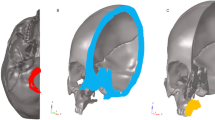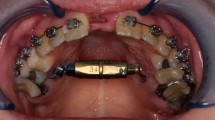Abstract
Objectives
To evaluate surgically assisted rapid maxillary expansion (SARME), with osteotomies separating the maxilla into two segments (SARME-2S) and three segments (SARME-3S), on obstruction symptoms and nasal cavity dimensions in patients with maxillary transverse skeletal deficiency (MTSD).
Materials and methods
Sixteen patients with MTSD of 7 mm or above were evaluated in each group, for a total of 32 patients. All patients were evaluated pre- and postoperatively up to 10 months after the expander activations. The minimum cross-sectional area (MCA) and the volume of the nasal cavities were identified by acoustic rhinometry. The Nasal Obstruction Symptom Evaluation (NOSE) scale questionnaire was applied. The palate surface area (PSA) was measured, via digitized maxillary models, as a criterion for comparison with the other variables studied.
Results
There was no difference between the groups (p = 0.370) and was verified a significant increase in PSA postoperatively. MCA showed a small increase without statistical significance, and together with the volume of the nasal cavities remained constant during the study. NOSE scale scores decreased significantly in the postoperative periods, implying a decrease in nasal obstruction symptoms in both groups.
Conclusions
SARME with two and three segments show similar results, and both may improve nasal obstruction symptoms when present in patients with MTSD.
Clinical relevance
SARME, regardless of the chosen surgical technique, should follow the recommendation to correct just the MTSD. While an improvement in nasal breathing is expected, this must be understood as likely, but not certain.





Similar content being viewed by others
Data availability
The data analyzed in this study are available upon request to the corresponding author.
References
Aloise AC, Pereira MD, Hino CT, Filho AG, Ferreira LM (2007) Stability of the transverse dimension of the maxilla after surgically assisted rapid expansion. J Craniofac Surg 18:860–865. https://doi.org/10.1097/scs.0b013e3180a77237
Haas Junior OL, Guijarro-Martínez R, de Sousa Gil AP, da Silva ML, de Oliveira RB, Hernández-Alfaro F (2017) Stability and surgical complications in segmental Le Fort I osteotomy: a systematic review. Int J Oral Maxillofac Surg 46:1071–1087. https://doi.org/10.1016/j.ijom.2017.05.011
Barone TR, Cahali MB, Vasconcelos C, Barone JR (2020) A comparison of tooth-borne and bone-anchored expansion devices in SARME. Oral Maxillofac Surg 24:181–187. https://doi.org/10.1007/s10006-020-00837-8
Manganello-Souza LC, Pacheco DF, da Silva AA (2003) Dentofacial deformity secondary to a severe trauma of the middle third of the face in infancy. J Oral Maxillofac Surg 61:1220–1224. https://doi.org/10.1016/S0278-2391(03)00687-6
Chhatwani S, Schudlich K, Möhlhenrich SC, Pugachev A, Bicsak A, Ludwig B, Hassfeld S, Danesh G, Bonitz L (2021) Evaluation of symmetry behavior of surgically assisted rapid maxillary expansion with simulation-driven targeted bone weakening. Clin Oral Investig 25:6717–6728. https://doi.org/10.1007/s00784-021-03958-w
Landes CA, Laudemann K, Schübel F, Petruchin O, Mack M, Kopp S, Sader RA (2009) Comparison of tooth- and bone-borne devices in surgically assisted rapid maxillary expansion by three-dimensional computed tomography monitoring: transverse dental and skeletal maxillary expansion, segmental inclination, dental tipping, and vestibular bone resorption. J Craniofac Surg 20:1132–1141. https://doi.org/10.1097/scs.0b013e3181abb430
Lo Giudice A, Spinuzza P, Rustico L, Messina G, Nucera R (2020) Short-term treatment effects produced by rapid maxillary expansion evaluated with computed tomography: a systematic review with meta-analysis. Korean J Orthod 50:314–323. https://doi.org/10.4041/kjod.2020.50.5.314
Pereira MD, de Abreu RAM, Prado GPR, Ferreira LM (2012) Strategies for surgically assisted rapid maxillary expansion according to the region of transverse maxillary deficiency. Int J Oral Maxillofac Surg 41:1127–1130. https://doi.org/10.1016/j.ijom.2012.03.028
Lin L, Ahn HW, Kim SJ, Moon SC, Kim SH, Nelson G (2015) Tooth-borne vs bone-borne rapid maxillary expanders in late adolescence. Angle Orthod 85:253–262. https://doi.org/10.2319/030514-156.1
Oliveira TFM, Pereira-Filho VA, Gabrielli MAC, Gonçales ES, Santos-Pinto A (2016) Effects of lateral osteotomy on surgically assisted rapid maxillary expansion. Int J Oral Maxillofac Surg 45:490–496. https://doi.org/10.1016/j.ijom.2015.11.011
Al-Ouf K, Krenkel C, Hajeer MY, Sakka S (2010) Osteogenic uni- or bilateral form of the guided rapid maxillary expansion. J Craniomaxillofac Surg 38:160–165. https://doi.org/10.1016/j.jcms.2009.03.011
Habersack K, Becker J, Ristow O, Paulus GW (2014) Dental and skeletal effects of two-piece and three-piece surgically assisted rapid maxillary expansion with complete mobilization: a retrospective cohort study. J Oral Maxillofac Surg 72:2278–2288. https://doi.org/10.1016/j.joms.2014.04.013
Prado GPR, Koga AF, Furtado FMGP, Ferreira LM, Pereira MD (2021) Two- and three-segment surgically assisted rapid maxillary expansion: a clinical trial. Plast Reconstr Surg 148:1086–1097. https://doi.org/10.1097/PRS.0000000000008491
Pereira PAA, Canellas JV, Souza RB, Tiwana PS, Medeiros PJ, Ritto FG (2022) Three-segment versus 2-segment surgically assisted rapid maxillary expansion. Oral Surg Oral Med Oral Pathol Oral Radiol 133:264–270. https://doi.org/10.1016/j.oooo.2021.06.002
Smith T, Ghoneima A, Stewart K, Liu S, Eckert G, Halum S, Kula K (2012) Three-dimensional computed tomography analysis of airway volume changes after rapid maxillary expansion. Am J Orthod Dentofac Orthop 141:618–626. https://doi.org/10.1016/j.ajodo.2011.12.017
Yavan MA, Kaya S, Kervancioglu P, Kocahan S (2021) Evaluation of effects of a modified asymmetric rapid maxillary expansion appliance on the upper airway volume by cone beam computed tomography. J Dent Sci 16:58–64. https://doi.org/10.1016/j.jds.2020.05.019
Mitsuda ST, Pereira MD, Passos AP, Hino CT, Ferreira LM (2010) Effects of surgically assisted rapid maxillary expansion on nasal dimensions using acoustic rhinometry. Oral Surg Oral Med Oral Pathol Oral Radiol Endod 109:191–196. https://doi.org/10.1016/j.tripleo.2009.09.011
Görgülü S, Gokce SM, Olmez H, Sagdic D, Ors F (2011) Nasal cavity volume changes after rapid maxillary expansion in adolescents evaluated with 3-dimensional simulation and modeling programs. Am J Orthod Dentofacial Orthop 140:633–640. https://doi.org/10.1016/j.ajodo.2010.12.020
El Bahrawy M, Shuman M (2021) The role of fiberoptic sinoscopy in evaluation the effect of surgically rapid maxillary expansion on the nasal airways. Al-Azhar Assiut Dent J 4:21–30. https://doi.org/10.21608/aadj.2021.163349
Magnusson A, Bjerklin K, Nilsson P, Jönsson F, Marcusson A (2011) Nasal cavity size, airway resistance, and subjective sensation after surgically assisted rapid maxillary expansion: a prospective longitudinal study. Am J Orthod Dentofacial Orthop 140:641–651. https://doi.org/10.1016/j.ajodo.2010.11.024
Pereira-Filho VA, Monnazzi MS, Gabrielli MA, Spin-Neto R, Watanabe ER, Gimenez CM, Santos-Pinto A, Gabrielli MF (2014) Volumetric upper airway assessment in patients with transverse maxillary deficiency after surgically assisted rapid maxillary expansion. Int J Oral Maxillofac Surg 43:581–586. https://doi.org/10.1016/j.ijom.2013.11.002
Menegat F, Monnazzi MS, Silva BN, de Moraes M, Gabrielli MA, Pereira-Filho VA (2015) Assessment of nasal obstruction symptoms using the NOSE scale after surgically assisted rapid maxillary expansion. Int J Oral Maxillofac Surg 44:1346–1350. https://doi.org/10.1016/j.ijom.2015.06.018
Alagoz E, Unver T, Seker ED, Kurt G, Senturk E, Ozdem A, Dolanmaz D (2022) Evaluating the changes in nasal airway volume and nasal airflow after surgically assisted rapid maxillary expansion. Oral Surg Oral Med Oral Pathol Oral Radiol 134:533–542. https://doi.org/10.1016/j.oooo.2022.04.047
Stewart MG, Witsell DL, Smith TL, Weaver EM (2004) Development and validation of the Nasal Obstruction Symptom Evaluation (NOSE) scale. Otolaryngol Head Neck Surg 130:157–163. https://doi.org/10.1016/j.otohns.2003.09.016
Camps-Perepérez I, Guijarro-Martínez R, Peiró-Guijarro MA, Hernández-Alfaro F (2017) The value of cone beam computed tomography imaging in surgically assisted rapid palatal expansion: a systematic review of the literature. Int J Oral Maxillofac Surg 46:827–838. https://doi.org/10.1016/j.ijom.2017.01.017
Liu K, Wei H, Dai J, Wang X (2020) Does nasal cavity enlargement associated with respiratory function improvement after surgically assisted rapid maxillary expansion? J Craniofac Surg 31:829–831. https://doi.org/10.1097/SCS.0000000000006245
Calvo-Henriquez C, Megias-Barrera J, Chiesa-Estomba C, Lechien JR, Maldonado Alvarado B, Ibrahim B, Suarez-Quintanilla D, Kahn S, Capasso R (2021) The impact of maxillary expansion on adults’ nasal breathing: a systematic review and meta-analysis. Am J Rhinol Allergy 35:923–934. https://doi.org/10.1177/1945892421995350
Moher D, Hopewell S, Schulz KF, Montori V, Gøtzsche PC, Devereaux PJ, Elbourne D, Egger M, Altman DG (2010) CONSORT 2010 explanation and elaboration: updated guidelines for reporting parallel group randomised trials. BMJ 340:c869. https://doi.org/10.1136/bmj.c869
Betts NJ, Vanarsdall RL, Barber HD, Higgins-Barber K, Fonseca RJ (1995) Diagnosis and treatment of transverse maxillary deficiency. Int J Adult Orthodon Orthognath Surg 10:75–96
Betts NJ (2016) Surgically assisted maxillary expansion. Atlas Oral Maxillofac Surg Clin North Am 24:67–77. https://doi.org/10.1016/j.cxom.2015.10.003
Landes CA, Laudemann K, Petruchin O, Revilla C, Seitz O, Kopp S, Ludwig B, Sader RA (2012) Advantages and limits of 3-segment (paramedian) versus 2-segment (median) surgically assisted rapid maxillary expansion (SARME). Oral Surg Oral Med Oral Pathol Oral Radiol 113:29–40. https://doi.org/10.1016/j.tripleo.2011.01.013
Bezerra TF, Padua FG, Pilan RR, Stewart MG, Voegels RL (2011) Cross-cultural adaptation and validation of a quality of life questionnaire: the nasal obstruction symptom evaluation questionnaire. Rhinology 49:227–231. https://doi.org/10.4193/Rhino10.019
Ribeiro Prado GP, Pereira MD, Rocha Biló JP, Furtado F, Ferreira LM (2013) Stability of surgically assisted rapid palatal expansion: a randomized trial. J Dent Res 92:49S-54S. https://doi.org/10.1177/0022034513486899
Hilberg O, Jackson AC, Swift DL, Pedersen OF (1989) Acoustic rhinometry: evaluation of nasal cavity geometry by acoustic reflection. J Appl Physiol (1985) 66(1):295–303. https://doi.org/10.1152/jappl.1989.66.1.295
Doruk C, Sökücü O, Biçakçi AA, Yilmaz U, Taş F (2007) Comparison of nasal volume changes during rapid maxillary expansion using acoustic rhinometry and computed tomography. Eur J Orthod 29:251–255. https://doi.org/10.1093/ejo/cjl069
Zambon CE, Ceccheti MM, Utumi ER, Pinna FR, Machado GG, Peres MP, Voegels RL (2012) Orthodontic measurements and nasal respiratory function after surgically assisted rapid maxillary expansion: an acoustic rhinometry and rhinomanometry study. Int J Oral Maxillofac Surg 41:1120–1126. https://doi.org/10.1016/j.ijom.2011.12.037
Aras A, Akay MC, Cukurova I, Günbay T, Işiksal E, Aras I (2010) Dimensional changes of the nasal cavity after transpalatal distraction using bone-borne distractor: an acoustic rhinometry and computed tomography evaluation. J Oral Maxillofac Surg 68:1487–1497. https://doi.org/10.1016/j.joms.2009.09.079
Seeberger R, Kater W, Davids R, Thiele OC (2010) Long term effects of surgically assisted rapid maxillary expansion without performing osteotomy of the pterygoid plates. J Craniomaxillofac Surg 38:175–178. https://doi.org/10.1016/j.jcms.2009.07.003
Baraldi CE, Pretto SM, Puricelli E (2007) Evaluation of surgically assisted maxillary expansion using acoustic rhinometry and postero-anterior cephalometry. Int J Oral Maxillofac Surg 36:305–309. https://doi.org/10.1016/j.ijom.2006.10.016
Babacan H, Sokucu O, Doruk C, Ay S (2006) Rapid maxillary expansion and surgically assisted rapid maxillary expansion effects on nasal volume. Angle Orthod 76:66–71. https://doi.org/10.1043/0003-3219(2006)076[0066:RMEASA]2.0.CO;2
Berretin-Felix G, Yamashita RP, Filho HN, Gonales ES, Trindade AS Jr, Trindade IE (2006) Short- and long-term effect of surgically assisted maxillary expansion on nasal airway size. J Craniofac Surg 17:1045–1049. https://doi.org/10.1097/01.scs.0000234987.84615.0c
Zambon CE, Cherobin GB, Utumi ER, Machado GG, de Vasconcellos FAF, Peres MPSM, Pilan RRM, Voegels RL, Pinna FR (2022) Computational fluid dynamics and NOSE scale to assess nasal respiratory function, and correlation with linear maxillary measurements after surgically assisted rapid maxillary expansion. Int J Oral Maxillofac Surg 52(8):875–884. https://doi.org/10.1016/j.ijom.2022.10.008
Buck LM, Dalci O, Darendeliler MA, Papadopoulou AK (2016) Effect of surgically assisted rapid maxillary expansion on upper airway volume: a systematic review. J Oral Maxillofac Surg 74:1025–1043. https://doi.org/10.1016/j.joms.2015.11.035
Acknowledgements
The authors would like to thank Dr. Mitti Koyama for her support in the statistical analysis and also to all the patients who participated in this research.
Funding
This study was supported by the governmental agency Fundação de Amparo a Pesquisa do Estado de São Paulo (grant number10/52179–6).
Author information
Authors and Affiliations
Contributions
A.A.F.S.: contributed to design, data acquisition, analysis and interpretation, draft, and critical revision of the manuscript; G.P.R.P.: contributed to data acquisition, analysis and interpretation, and critical revision of the manuscript; M.D.P.: contributed to conception, design, data acquisition and interpretation, and critical revision of the manuscript. All authors gave final approval and agree to be accountable for all aspects of the work.
Corresponding author
Ethics declarations
Ethical approval
All procedures involving human participants followed the ethical standards of the 1964 Helsinki declaration. This study was approval by the Research Ethics Committee of the Federal University of São Paulo, Brazil, under number 517.722. It was registered in the Brazilian Registry of Clinical Trials (ensaiosclinicos.gov.br) under code RBR-8rhkm25.
Informed consent
Informed consent was obtained from all individual participants included in the study.
Competing interests
The authors declare no competing interests.
Additional information
Publisher's note
Springer Nature remains neutral with regard to jurisdictional claims in published maps and institutional affiliations.
Rights and permissions
Springer Nature or its licensor (e.g. a society or other partner) holds exclusive rights to this article under a publishing agreement with the author(s) or other rightsholder(s); author self-archiving of the accepted manuscript version of this article is solely governed by the terms of such publishing agreement and applicable law.
About this article
Cite this article
da Silva, A.A.F., Prado, G.P.R. & Pereira, M.D. Randomized clinical trial of surgically assisted rapid maxillary expansion with two and three segments for nasal breathing. Clin Oral Invest 27, 6209–6219 (2023). https://doi.org/10.1007/s00784-023-05237-2
Received:
Accepted:
Published:
Issue Date:
DOI: https://doi.org/10.1007/s00784-023-05237-2




